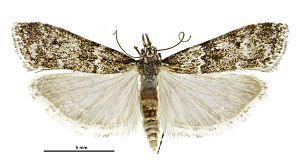Eudonia manganeutis facts for kids
Quick facts for kids Eudonia manganeutis |
|
|---|---|
 |
|
| Scientific classification | |
| Kingdom: | |
| Phylum: | |
| Class: | |
| Order: | |
| Family: | |
| Genus: |
Eudonia
|
| Species: |
E. manganeutis
|
| Binomial name | |
| Eudonia manganeutis (Meyrick, 1884)
|
|
| Synonyms | |
|
|
The Eudonia manganeutis is a small moth that belongs to the Crambidae family. It was first described by a scientist named Edward Meyrick in 1884. This special moth is found only in New Zealand, meaning it is endemic to that country.
Contents
Meet the New Zealand Moss Moth!
This interesting moth is a unique part of New Zealand's wildlife. It's known for its specific appearance and where it chooses to live. Like all moths, it goes through a fascinating life cycle, starting as a tiny egg, then a larva (caterpillar), a pupa, and finally, an adult moth.
What Does It Look Like?
The Eudonia manganeutis is a small moth. Its wingspan is about 17 to 18 millimeters wide. That's roughly the length of a small button!
- Its front wings are mostly light grey.
- They have a mix of white and tiny black speckles.
- There are also two white lines across the wings, each with a dark edge.
- The back wings are a lighter whitish-grey color.
- They have a slightly darker grey edge.
Adult moths have been seen flying around in January. This is when they are most active.
Where Does It Live?
This moth is special because it is endemic to New Zealand. This means you won't find it naturally anywhere else in the world! It's a native species that has adapted perfectly to the unique environment of New Zealand.
What Does It Eat?
The young moths, which are called larvae or caterpillars, have a very specific diet. They love to eat moss! Mosses are small, soft green plants that often grow in damp, shady places. This diet helps the larvae grow and get ready to become adult moths.

